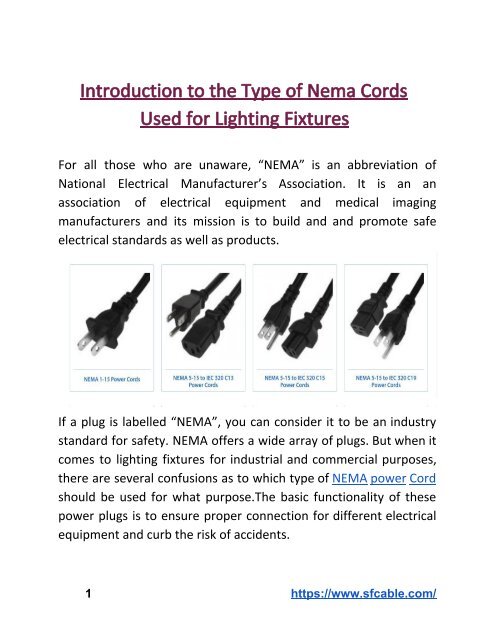Introduction to the Type of Nema Cords Used for Lighting Fixtures
The most commonly used NEMA power cords and plugs which connect lighting fixtures to the receptacles and their specifications as standardized by NEMA.NEMA power are used domestic AC electrical appliances most in North America and other countries which follow the NEMA standards. SF Cable is a leading retailers of cables and cords online and stocks a wide variety of NEMA power cords as well. https://www.sfcable.com/nema-power-cords.html
The most commonly used NEMA power cords and plugs which connect lighting fixtures to the receptacles and their specifications as standardized by NEMA.NEMA power are used domestic AC electrical appliances most in North America and other countries which follow the NEMA standards. SF Cable is a leading retailers of cables and cords online and stocks a wide variety of NEMA power cords as well. https://www.sfcable.com/nema-power-cords.html
Create successful ePaper yourself
Turn your PDF publications into a flip-book with our unique Google optimized e-Paper software.
<strong>Introduction</strong> <strong>to</strong> <strong>the</strong> <strong>Type</strong> <strong>of</strong> <strong>Nema</strong> <strong>Cords</strong><br />
<strong>Used</strong> <strong>for</strong> <strong>Lighting</strong> <strong>Fixtures</strong><br />
For all those who are unaware, “NEMA” is an abbreviation <strong>of</strong><br />
National Electrical Manufacturer’s Association. It is an an<br />
association <strong>of</strong> electrical equipment and medical imaging<br />
manufacturers and its mission is <strong>to</strong> build and and promote safe<br />
electrical standards as well as products.<br />
If a plug is labelled “NEMA”, you can consider it <strong>to</strong> be an industry<br />
standard <strong>for</strong> safety. NEMA <strong>of</strong>fers a wide array <strong>of</strong> plugs. But when it<br />
comes <strong>to</strong> lighting fixtures <strong>for</strong> industrial and commercial purposes,<br />
<strong>the</strong>re are several confusions as <strong>to</strong> which type <strong>of</strong> NEMA power Cord<br />
should be used <strong>for</strong> what purpose.The basic functionality <strong>of</strong> <strong>the</strong>se<br />
power plugs is <strong>to</strong> ensure proper connection <strong>for</strong> different electrical<br />
equipment and curb <strong>the</strong> risk <strong>of</strong> accidents.<br />
1 https://www.sfcable.com/
NEMA power are used domestic AC electrical appliances most in<br />
North America and o<strong>the</strong>r countries which follow <strong>the</strong> NEMA<br />
standards. SF Cable is a leading retailers <strong>of</strong> cables and cords online<br />
and s<strong>to</strong>cks a wide variety <strong>of</strong> NEMA power cords as well.<br />
Our collection includes NEMA 1-15 Power <strong>Cords</strong>, NEMA 5-15 <strong>to</strong> IEC<br />
320 C13 Power <strong>Cords</strong>, NEMA 5-15 <strong>to</strong> IEC 320 C15 Power <strong>Cords</strong>,<br />
NEMA 5-15 <strong>to</strong> IEC 320 C19 Power <strong>Cords</strong>, NEMA 5-15 <strong>to</strong> IEC 320 C5<br />
Power <strong>Cords</strong>, NEMA 5-15P <strong>to</strong> NEMA 5-15R Power <strong>Cords</strong> Extension,<br />
NEMA 5-20 Power <strong>Cords</strong>, NEMA 6-15 Power <strong>Cords</strong>, NEMA 6-20<br />
Power <strong>Cords</strong>, NEMA L5-15 Locking Power <strong>Cords</strong>, NEMA L5-20<br />
Locking Power <strong>Cords</strong> and NEMA L6-20 Locking Power <strong>Cords</strong>.<br />
We source all <strong>the</strong>se power cords directly from <strong>the</strong> manufacturers<br />
<strong>to</strong> eliminate <strong>the</strong> middlemen charges and <strong>of</strong>fer quality products at<br />
competitive prices. All our products are environment friendly. We<br />
also provide good after sales service and lifetime technical support<br />
on all our cable products.<br />
The most commonly used NEMA power plugs which connect<br />
lighting fixtures <strong>to</strong> <strong>the</strong> receptacles. These power plugs are covered<br />
by ANSI/NEMA WD-6 standard which is set by National Electrical<br />
Manufacturers Association, abbreviated as NEMA.<br />
2 https://www.sfcable.com/
Specifications About NEMA Power Power <strong>Cords</strong><br />
The wiring devices standardized by NEMA have a current rating <strong>of</strong><br />
15 <strong>to</strong> 60 amps, and voltage rating <strong>of</strong> 125 <strong>to</strong> 600 volts. This<br />
standardization is done based on orientation, shapes and blade<br />
widths. NEMA Plugs ensure that <strong>the</strong> equipment needing a<br />
particular voltage and current is not plugged in<strong>to</strong> a wrong electrical<br />
system.<br />
Usually 15 and 20 amp NEMA plugs with both straight-blade and<br />
twist-lock varieties are used <strong>for</strong> with lighting fixtures. Here’s a<br />
breakdown <strong>to</strong> each <strong>of</strong> <strong>the</strong>se power plugs and <strong>the</strong>ir features.<br />
NEMA 5-15<br />
Receptacle used: 125 V<br />
Plug: 15A<br />
NEMA 5-15 is used with 120V lighting system. It is a standard<br />
grounded straight blade plug used in North America, Canada and<br />
different parts <strong>of</strong> Mexico.<br />
NEMA L5-15<br />
Receptacle used: 125V<br />
Plug: 15A<br />
NEMA L5-15 is a twist-lock version <strong>of</strong> 120V plug. Such plugs are<br />
commonly used <strong>to</strong> s<strong>to</strong>p unintentional disconnects and with<br />
industrial applications that likely <strong>to</strong> vibrate.<br />
3 https://www.sfcable.com/
NEMA L7-15<br />
Receptacle used: 277V<br />
Plug: 15A<br />
NEMA L7-15 plugs are <strong>the</strong> most popularly used twist-lock plugs<br />
with 277V lighting systems.<br />
NEMA L7-20<br />
Receptacle used: 277V<br />
Plug: 20A<br />
The 277V lighting systems <strong>of</strong>ten use NEMA L7-20 plug. You can<br />
identify <strong>the</strong> difference between 20A and 15 A by looking <strong>to</strong>wards<br />
<strong>the</strong> direction <strong>of</strong> locking ground tab. 20A points outwards whereas<br />
15A points <strong>to</strong>wards <strong>the</strong> center.<br />
You can look in<strong>to</strong> various charts and images in order <strong>to</strong> identify<br />
different plugs and sockets. The plug usually has curved or straight<br />
blades that stick out from <strong>the</strong> plug body. This part is considered <strong>to</strong><br />
be <strong>the</strong> male end <strong>of</strong> <strong>the</strong> connection. And sockets or receptacle<br />
having corresponding slots are considered <strong>to</strong> be <strong>the</strong> female end <strong>of</strong><br />
connection.<br />
See More Products Here:<br />
●<br />
●<br />
●<br />
●<br />
●<br />
https://www.sfcable.com/<br />
https://www.sfcable.com/network-e<strong>the</strong>rnet-cables.html<br />
https://www.sfcable.com/hdmi-cables.html<br />
https://www.sfcable.com/bulk-network-cable.html<br />
https://www.sfcable.com/nema-power-cords.html<br />
4 https://www.sfcable.com/


















